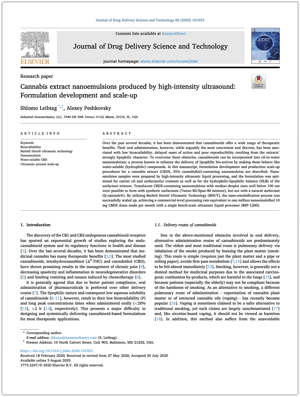Shlomo Leibtag, Alexey S. Peshkovsky, Journal of Drug Delivery Science and Technology, Volume 60, August 2020.

Over the past several decades, it has been demonstrated that cannabinoids offer a wide range of therapeutic benefits. Their oral administration, however, while arguably the most convenient and discrete, has been associated with low bioavailability, delayed onset of action and poor reproducibility resulting from the extracts’ strongly lipophilic character. To overcome these obstacles, cannabinoids can be incorporated into oil-in-water nanoemulsions: a process known to enhance the delivery of lipophilic bio-actives by making them behave like water-soluble (hydrophilic) compounds. In this manuscript, formulation development and production scale-up procedures for a cannabis extract (CBDX, 55% cannabidiol)-containing nanoemulsion are described. Nano-emulsion samples were prepared by high-intensity ultrasonic liquid processing, and the formulation was optimized for carrier oil and surfactant(s) contents as well as for the hydrophilic-lipophilic balance (HLB) of the surfactant mixture. Translucent CBDX-containing nanoemulsions with median droplet sizes well below 100 nm were possible to form with synthetic surfactants (Tween 80/Span 80 mixture), but not with a natural surfactant (Q-naturale®). By utilizing Barbell Horn® Ultrasonic Technology (BHUT), the nano-emulsification process was successfully scaled up, achieving a commercial-level processing rate equivalent to one million nanoemulsified 10 mg CBDX doses made per month with a single bench-scale ultrasonic liquid processor (BSP-1200).
Industrial Sonomechanics is a R&D, equipment design and process consulting firm, specializing in high-power ultrasonic technology for liquid treatment. Our mission is to help businesses implement their ultrasound-assisted processes on lab, pilot and industrial scales.
[fa icon="phone"] 786-233-9255
[fa icon="envelope"] contact@sonomechanics.com
[fa icon="home"] 7440 SW 50th Terrace #109, Miami FL 33155